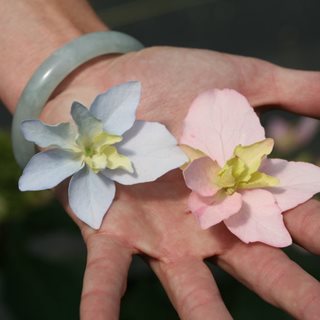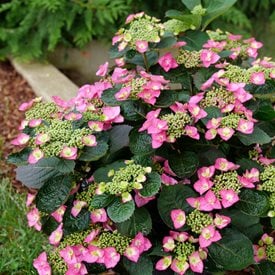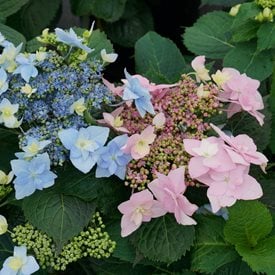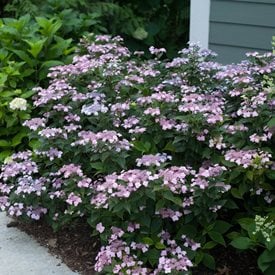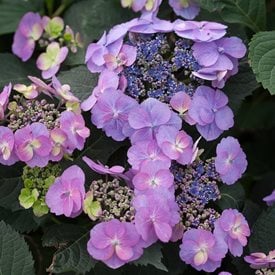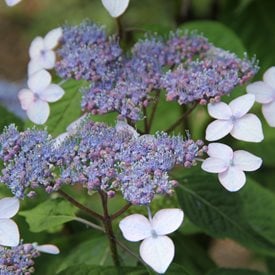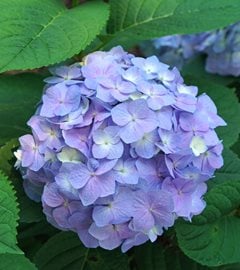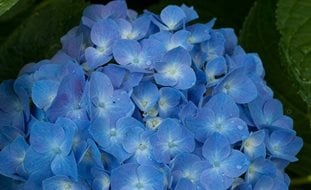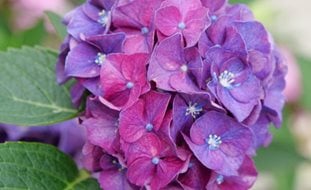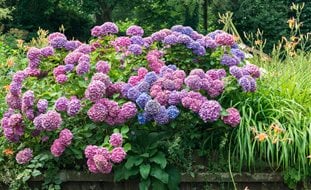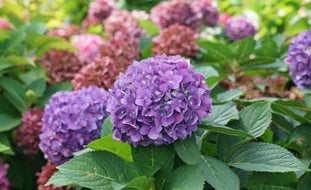Hydrangea Serrata - A Growing Guide for Mountain Hydrangea
With a compact habit and long-lasting attractive blooms, Hydrangea serrata offers multi-seasonal appeal for a variety of landscapes, from small urban lots to suburban properties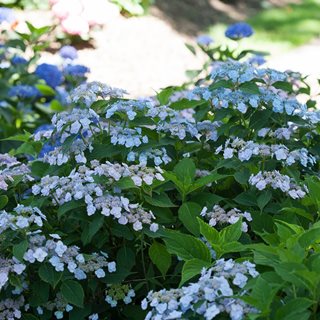
Tiny Tuff Stuff™ reblooming mountain hydrangea; blue in acidic soil, pink in alkaline. Photo by: Proven Winners.
Hydrangeas are one of the most beloved garden shrubs, with different types that are acclimated to a range of growing regions. Mountain hydrangea (Hydrangea serrata), which is closely related to its better known cousin bigleaf hydrangea (H. macrophylla), produces elegant lacecap flowers in soft shades of blue, pink, lavender, or white.
While both are native to Japan and Korea, bigleaf hydrangea grows in the mild coastal regions, while mountain hydrangea originates from the colder mountainous regions, making it hardier and more resilient. Flower buds on mountain hydrangea have better cold tolerance, and are less likely to be damaged by late frosts. This compact shrub has improved reliability and flowering in colder growing zones.
Their smaller stature makes them ideal for beds, borders, and containers. Here’s how to grow and use mountain hydrangea in your yard.
On this page: Basics | Planting | Care | Pictures | Frequently Asked Questions| Landscaping Ideas
On this page:
- MOUNTAIN HYDRANGEA OVERVIEW
- PLANTING MOUNTAIN HYDRANGEAS
- MOUNTAIN HYDRANGEA CARE
- MOUNTAIN HYDRANGEA VARIETIES
- FREQUENTLY ASKED QUESTIONS
- LANDSCAPING WITH MOUNTAIN HYDRANGEAS
MOUNTAIN HYDRANGEA OVERVIEW
Botanical name:
Hydrangea serrata
Common names:
Mountain hydrangea, tea of heaven
Plant type:
Deciduous shrub
Zones:
5-9
Exposure:
Full sun to partial shade
Height/Spread:
2 to 5 feet tall, 2 to 6 feet wide, depending on the variety
Growth habit:
Bushy, mounding, or compact habit
Bloom time:
Early summer to fall
Flowers:
Flat-topped lacecap flowers up to 8 inches wide consist of a central cluster of tiny fertile florets surrounded by larger single or double sterile petals. Flower color can be blue, lavender, or pink, depending on soil pH. Plants grown in acidic soils will have blue or lavender flowers, while those in neutral or alkaline soils produce pink or red blooms.
Foliage:
Dark-green leaves are 2 to 6 inches long and oval-shaped with pointed ends. Foliage has a rough texture and serrated edges. Some varieties have insignificant fall color, while others have foliage that turns red or burgundy.
Are mountain hydrangeas poisonous?
All parts of hydrangeas are mildly to moderately toxic to pets and children. Consult a veterinarian or doctor if your pet or child exhibits any symptoms of distress. See more Common Poisonous Plants for Dogs and Cats.
Are mountain hydrangeas deer resistant?
Mountain hydrangea is susceptible to grazing in deer-prone areas. These foragers are particularly fond of the flowers and tender new buds. Use a repellent spray, protect plants with netting, or substitute mountain hydrangea with other more deer-resistant bushes.
PLANTING MOUNTAIN HYDRANGEAS
When to plant:
Mountain hydrangea can be planted during the cooler months of spring and fall to avoid extreme temperatures, which can cause plant stress and shock.
Where to plant:
Choose a site with full sun to partial shade, or dappled sunlight throughout the day. Plants grown in northern climates can tolerate full sun, while afternoon shade is essential in hotter climates to prevent foliage burn.
How to plant:
Loosen soil in the planting area and amend with compost or other rich organic matter. Dig a hole twice as wide and slightly deeper than the root ball. Remove the plant from its nursery container and loosen roots if potbound. Place in the hole so the top of the root ball is level with the surrounding soil. Fill in the hole with soil, tamp down gently to remove air pockets, and water thoroughly. Provide regular water until plants are established. Space plants 3 to 5 feet apart, depending on the variety.
Planting hydrangeas in pots:
- Use a bagged potting mix rather than garden soil.
- Mix in a slow-release fertilizer.
- Leave 1 to 2 inches between the top of the soil and the rim of the pot for watering.
- Make sure the pot has drainage holes and has room for the plant to grow.
Learn more about growing hydrangeas in pots.
MOUNTAIN HYDRANGEA CARE
Soil:
Mountain hydrangea plants prefer rich, well-amended soil. Add compost or other organic matter to the native soil and provide adequate drainage. Mulch plants around the base with several inches of shredded bark to provide additional nutrients, retain moisture, and insulate the root zone from cool and hot temperatures. For containers, use an all-purpose potting mix.
Amendments and fertilizer:
Apply a slow-release granular fertilizer in early spring. Use an all-purpose balanced fertilizer, or one that’s especially formulated for trees and shrubs. Add lime to the soil to make it more alkaline (for pink or red blooms). To increase soil acidity, add sulfur or aluminum sulfate (for blue or lavender blooms). Learn more about changing hydrangea color.
Water:
Keep soil evenly moist, but not soggy, and don’t allow soil to dry out completely. Water more frequently during prolonged heat and dry spells. Container plants will need more frequent watering than those in the ground. Avoid overhead watering to discourage diseases. Overwatering may cause root rot.
How to prune mountain hydrangeas:
Older varieties bloom on old wood (prune right after flowering, if needed), while some newer cultivars bloom on both old and new wood. Plants require minimal pruning. In early spring, remove any dead, diseased or damaged branches and lightly shape plants as needed. To rejuvenate established plants and improve air circulation, remove up to one-third of the older stems back to the base every few years.
Pests and diseases:
Healthy plants are resistant to pests and diseases. Possible pests include aphids, slugs, mites, and Japanese beetles. Diseases include bacterial wilt, leaf spot, bud blight, root rot, and powdery mildew.
MOUNTAIN HYDRANGEA VARIETIES
FREQUENTLY ASKED QUESTIONS
Do mountain hydrangeas like sun or shade?
Hydrangea serrata prefers morning sun and afternoon shade, or dappled sunlight. Plants will bloom best with at least 3 to 6 hours of direct sunlight. Too much shade will result in fewer flowers.
Do mountain hydrangeas bloom all summer?
This hydrangea type blooms for weeks during summer, with reblooming varieties that can flower even longer.
Do you deadhead mountain hydrangeas?
Deadheading is not necessary, but can neaten plant appearance. Remove faded blooms just below the flower head. Pruning too far down the stem can remove flower buds for the following growing season.
Does Hydrangea serrata bloom on old and new wood?
Older varieties of mountain hydrangea bloom on the previous year’s growth (old wood). Newer reblooming varieties flower on both old and new wood.
Try this Stunning Hydrangea for Long-Lasting Color!
LET'S DANCE SKY VIEW® Reblooming hydrangea
Hydrangea macrophylla x serrata
Zones: 4-9
Height/Spread: 2 to 3 feet tall, 2 to 4 feet wide
Color: Blue, pink, or purple flowers; green foliage
The best characteristics of bigleaf and mountain hydrangeas are combined with this hybrid reblooming hydrangea. Let’s Dance Sky View® produces cold-hardy flower buds on old wood up and down the entire length of the stems, an improvement for those who live in areas with late spring frosts. Flowers on new growth are produced more quickly, resulting in a longer, continuous bloom cycle throughout summer and fall. Flower color varies according to soil pH, opening with a honeydew green eye before maturing to its full blue, pink, or purple coloring. In areas with alkaline or neutral soil, add aluminum sulfate to the soil for dazzling sky-blue flowers.
Watch this video for more information on this popular hydrangea.
LANDSCAPING WITH MOUNTAIN HYDRANGEAS
There are many ways to use mountain hydrangeas in your landscape. Here’s how:
For borders and landscapes: With its compact habit, mountain hydrangea is versatile as hedging, in foundation or shrub plantings, mixed borders, or mass plantings.
For slopes and hillsides: Mountain hydrangea can be massed along a slope or hillside to help stabilize the soil.
For containers: Dwarf varieties can be planted in containers to adorn a deck or patio, or used as a showy focal point in the landscape.
- Plant mountain hydrangea in a pollinator border to attract bees, butterflies, and other insect pollinators.
- Use in a foundation planting as a low-maintenance shrub that needs little pruning.
- Place mountain hydrangea in a mixed border for long-lasting color throughout summer.
- Include mountain hydrangea in a cottage-style garden in combination with peonies, roses, lavender, foxglove, and phlox for romantic charm.
- Use mountain hydrangea as pathway edging in a semi-shaded area.
- Combine with other trees, shrubs, and perennials in a woodland setting for a layered tapestry of color.
- Plant a dwarf variety in a large container and place near your home’s entrance for a welcoming display.
- Mountain hydrangea can be planted around a deck or patio for color and privacy.
- Mass mountain hydrangea shrubs along a slope or hillside to help stem erosion.
- Plant a row of mountain hydrangeas to divide garden areas or define a property line.
